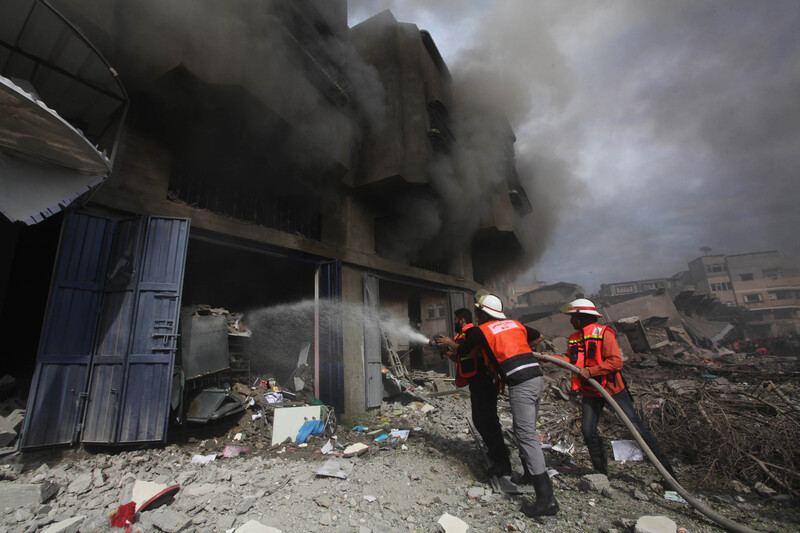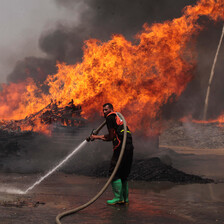The Electronic Intifada Gaza City 16 April 2013

Palestinian firefighters extinguish a blaze after an Israeli air strike in Gaza City, 18 November 2012.
APA imagesWhen thousands of Palestinians poured into the streets of the Gaza Strip after the announcement of a ceasefire with Israel on the night of 21 November last year, they found many of them flooded.
Celebrants in areas hard-hit by eight days of Israeli airstrikes, artillery fire and naval shelling were particularly likely to find themselves wading through rivers of water. Firefighters had sprayed it to extinguish blazes at nearby bomb sites as missiles fell hours earlier.
“If we — if anyone — thinks of this as his job, he will not work,” said Yousef Khaled Zahar, general manager of the Civil Defense Directorate in Gaza.
“But because we believe in our people and our country, because we belong to this people, we work without ever thinking of the dangers. We are only concerned with serving our people.”
Zahar’s office sits inside the Civil Defense Directorate’s headquarters, the largest of its 16 stations, an orderly compound in Gaza City’s Tal al-Hawa neighborhood. Its rows of garages and offices lie among grassy fields and colorful murals of firefighters and other civil defense personnel at work, part of a campaign launched throughout the Gaza Strip to mark World Civil Defense Day on 1 March.
Unique role
The directorate, part of the Palestinian interior ministry in Gaza, fills a unique role. The ministry of health, along with the Palestine Red Crescent Society and other organizations, also field ambulances. But the directorate has sole responsibility for fire and rescue operations in the Gaza Strip.
Over the eight days of Israeli attacks and retaliatory fire by Palestinian resistance groups in November, ambulance, fire and rescue teams worked ceaselessly. Their vehicles raced through streets that were often otherwise deserted, sirens punctuating the incessant explosions around them.
“In this war, there was no direct targeting of civil defense,” Zahar said. “We did our best to arrange matters with the Red Cross. Civil defense was not targeted as much as in the 2008-2009 war. There was some damage from bombings of other buildings, but it wasn’t aimed directly at ours.”
The previous attack had been different. At around 11:30am on 27 December 2008, Israeli warplanes and helicopters launched coordinated airstrikes on more than 100 Gaza targets, including civil defense facilities, in under four minutes. At the time, Zahar had worked as the directorate’s general manager for only four months.
“They attacked us from the first moment,” he said. “They bombed our centers without warning. After that, they started to shoot us. We were targeted by snipers [while we were doing] our job in the field. We spent the whole war working from the streets, without any ability to enter our offices.”
Israel’s 2008-09 campaign killed 13 civil defense workers, injured 25 more, 17 of them seriously, and caused $2.5 million in damages to civil defense sites and equipment, Gaza’s Al-Mezan Center for Human Rights reported in March 2009. Ten additional non-police emergency workers were killed, and 25 injured, from other agencies throughout the Strip.
The Israeli offensive “created a catastrophic humanitarian disaster,” Al-Mezan Center stated in its report. “It was also a time in which the resilience of the local population came to the fore. In spite of the death and destruction all around them, the Palestinians in Gaza struggled to maintain life-sustaining services” (“The targeting of medical centers, ambulance teams and civil defense workers during the Israeli offensive “Operation Cast Lead” against the Gaza Strip,” 17 March 2009 [PDF]).
Zahar was among the wounded. “I was working in the field,” he said. “On one mission, I was crossing a road near Saraya [a security complex heavily bombed by Israel]. The Israelis targeted the Saraya buildings with eight rockets.”
“Because we were close to the place while crossing the road, I was injured,” he added, tracing scars from his head down his left arm and hand to his left leg.
Deliberate targeting
Other directorate employees suffered worse. When an Israeli helicopter shelled an apartment building, it struck three civil defense workers removing an elderly couple killed by a previous airstrike. “One lost his right foot, another the same, and the third lost both of his legs and his right hand. They had arrived in a civil defense vehicle and were wearing fluorescent vests. This is only one of our stories. There are many like that.”
At least one additional civilian, three-year-old Ahmad Sinwar, died after debris from Israel’s bombing of the civil defense headquarters during the first wave of airstrikes struck him in his adjacent home. “His brain had spilled out,” said his father, physician Reyad Sinwar, in a testimony taken by the Israeli human rights group B’Tselem (“Testimony: Three year old killed in Israeli bombing of building next to his home, Gaza City, December ‘08,” 31 December 2008).
Sinwar also told the The Los Angeles Times, “I never expected that the civil defense headquarters would be considered a military target” (“Gaza’s hospitals are overwhelmed,” 28 December 2008).
Israel soon announced that it had no intention of restricting its attacks to “military targets.” Captain Benjamin Rutland, an Israeli military spokesman, told the BBC that its list of “valid” targets “ranges from the strictly military institutions and includes the political institutions that provide the logistical funding and human resources for the terrorist arm [of Hamas]” (“Gaza conflict: who is a civilian?” 5 January 2009).
Military aggression against civil defense and other emergency services also caused an unknown number of deaths from the resulting lack of medical treatment.
“Some wounded people simply die while waiting for an ambulance,” Antoine Grand, head of the International Committee of the Red Cross’ Gaza office, said in January 2009. “This is of course absolutely appalling. The ambulances must reach the injured as fast as possible” (“Gaza: wounded people dying while waiting for ambulances,” International Committee of the Red Cross, 5 January 2009).
“Something strange in our sky”
Israel’s use of banned weapons like white phosphorous posed another challenge.
“We heard that something strange had appeared in our sky,” Zahar said. “We started to receive calls from people who had been fired upon. When we sent our our teams to respond, we found something very odd. If a small quantity of this weapon touches the body, it will reach the bone, destroying everything. We found not 10, not tens, but hundreds of people wounded by it. We tried using water to stop the fire, but that only increased it. So we used sand directly to suffocate the fire.”
“The unlawful use of white phosphorus was neither incidental nor accidental,” Human Rights Watch said in a March 2009 report. “It was repeated over time and in different locations, with the [Israeli army] ‘air-bursting’ the munition in populated areas up to the last days of its military operation. The total number of Palestinians killed and injured by white phosphorus is not known and will likely remain so.”
Civil defense crews persevered through 22 long, bloody days, Zahar said. “We did 1,200 missions during the war, including firefighting, rescue, and ambulances.”
Shortage of supplies
Israel’s siege of Gaza has struck another blow to the Civil Defense Directorate’s capacity, preventing the import of emergency vehicles, parts or supplies.
“Most of our machines and vehicles were manufactured in 1988 and 1989,” Zahar said. “The most recent was made in 2000. This puts us in a very bad situation.”
“We called on all the international associations and governments to provide us with new vehicles. All of them promised, and all of them lied. Directly, without any political words,” he laughs.
Driven to innovation by the lack of imports, civil defense crews have repaired old machinery and improvised new supplies with components available locally.
“We started to prepare our vehicles from the first moment after 2008 war,” Zahar said. “We collected spare parts from here and there to repair the damage. We succeeded in making some vehicles work for firefighting. By doing this, we covered the shortage.
“Just yesterday, we tested a new vehicle. It has the same ability as real firefighting trucks. Even the foam material used for fighting petroleum fires used to cost us $7 per liter. We started to work on it until we could prepare our own, which we used in the 2012 war. Now we do not need to bring it from the outside. We prepare it locally, costing us 50 cents per liter. Its efficiency is more than the original.”
Like any institution, the Civil Defense Directorate can never work ideally under siege, especially one intended to starve public services. But Zahar seems optimistic that the directorate is ready for the future.
“We have only the minimum level of vehicles,” he said. “But you can say that we have reached the point where we can do our work, at least at a minimal level.”
And while damage from November’s attacks pales in comparison to that of the attacks in 2008-2009, civil defense employees continue efforts to increase their ability to respond to emergencies.
“Our preparation is the same as what we did after the last war,” Zahar said. “We have our members. We have our belief in our people and this country. And we will do our best to protect our people from these dangers.”
Joe Catron is a US activist in Gaza, Palestine. He works with Palestinian groups and international solidarity networks, particularly in support of the boycott, divestment and sanctions (BDS) and prisoners’ movements. He blogs at joecatron.wordpress.com and can be followed on Twitter @jncatron.




